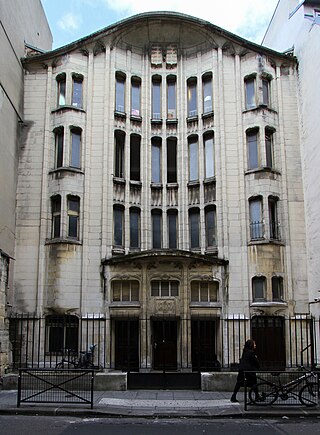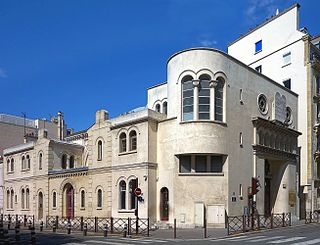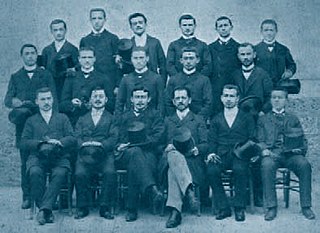
The Rue des Rosiers, which means "street of the rosebushes," is a street in the 4th arrondissement of Paris, France. It begins at the Rue Malher and proceeds northwest across the Rue Pavée, Rue Ferdinand Duval, Rue des Écouffes, and Rue des Hospitalières Saint-Gervais before it ends at the Rue Vieille du Temple.

The Agoudas Hakehilos Synagogue is an Orthodox Jewish congregation and synagogue, located at 10 rue Pavée, in Le Marais quarter, in the IVe arrondissement of Paris, France. The synagogue is commonly referred to as the Pavée synagogue, rue Pavée synagogue, or Guimard synagogue, and was completed in 1914, designed by Hector Guimard in the Art Nouveau style. The congregation worships in the Ashzenazi rite, led by Rav Moredekhai Rottenberg, the son of the late Rav Haim Yaakov Rottenberg, known as the Rouv. The synagogue is open to the public.
David Feuerwerker was a French Jewish rabbi and professor of Jewish history who was effective in the resistance to German occupation the Second World War. He was completely unsuspected until six months before the war ended, when he fled to Switzerland and his wife and baby went underground in France. The French government cited him for his bravery with several awards. After the war, he and his wife re-established the Jewish community of Lyon. He settled in Paris, teaching at the Sorbonne. In 1966, he and his family, grown to six children, moved to Montreal, where he developed a department of Jewish studies at the University of Montreal.

The Musée d'Art et d'Histoire du Judaïsme is the largest French museum of Jewish art and history. It is located in the Hôtel de Saint-Aignan in the Marais district in Paris.

The Great Synagogue in Lyon is an Orthodox Jewish congregation and synagogue located at 13 quai Tilsitt in the IIe arrondissement of Lyon, France. Designed by Abraham Hirsch in the Byzantine Revival style, the synagogue was built between 1863 and 1864 and renovated in 2014. The building was listed as a monument historique on 5 December 1984. The congregation worships in the Ashkenazi rite.

The Synagogue de Nazareth, officially Synagogue de la rue Nazareth, is an Orthodox Jewish congregation and synagogue, located on the Rue Notre-Dame-de-Nazareth, in the IIIe arrondissement of Paris, France. The synagogue is the oldest of the 'great' synagogues of Paris.

The Versailles Synagogue is a Jewish congregation and synagogue, located at 10, rue Albert Joly in Versailles in the Yvelines department, in the Île-de-France region of France. Built between 1884 and 1886 by the architect Alfred-Philibert Aldrophe, it was inaugurated in 1886, and is one of the oldest synagogues in the Île-de-France region. Mrs Furtado Heine provided significant financial support to the establishment of the synagogue.

The Synagogue of Neuilly is an Orthodox Jewish congregation and synagogue, located at 12 rue Ancelle, in Neuilly-sur-Seine, in the Hauts-de-Seine department, west of Paris, France. The synagogue was built in 1878. The congregation used to worship in the Ashkenazi rite; however is now Sephardi.

The Synagogue Don Isaac Abravanel, also known as the Synagogue de la Roquette, is an Orthodox Jewish congregation and synagogue, located in the XIe arrondissement of Paris, France. Designed by architects Alexandre Persitz and Arthur-Georges Héaume in the Modernist style, the synagogue was built in 1962 for Jews who emigrated to France from Algeria, Morocco and Tunisia as a result of decolonization. The congregation worships in the Sephardi rite.

The Synagogue of Lausanne is a Jewish congregation and synagogue, located at 1 Avenue de Florimont in Lausanne, Vaud, Switzerland. The building is a Cultural Property of National Significance.

The Beth Meir Synagogue, officially Beth Knesset Beth Meir,, is an Orthodox Jewish congregation and synagogue. located at 3 Rue du Castagno in Bastia, on the island of Corsica, in the Hauts-de-France region of France. It is the only synagogue on the island of Corsica; and the congregation worships in the Sephardic rite.

The Amiens Synagogue is an Orthodox Jewish congregation and synagogue, located in the city of Amiens in the Department of Somme, France. The synagogue, rededicated in 2017, replaced two previous buildings.

The Saint-Avold Synagogue is a Jewish congregation and synagogue, located at the corner of Rue des Americains and Rue de la Mertzelle near Place Paul-Collin in Saint-Avold, in the Moselle department in Grand Est in north-eastern France. The current synagogue building, completed in 1956, replaces a nearby synagogue destroyed during the German occupation of France in World War II.
Keren Or Synagogue is a Reform Jewish congregation and synagogue, located at 15 Rue Jules Vallès in Villeurbanne, in Lyon, in the Auvergne-Rhône-Alpes region of France.

The Synagogue of Arcachon, also Synagogue Temple Osiris, is a Jewish congregation and synagogue, located at 36 Avenue Gambetta in Arcachon, Gironde, in the Nouvelle-Aquitaine region of France. The congregation, Communauté Juive du Bassin d’Arcachon(in French), worships in the Sephardic rite.

The Synagogue des Tournelles is an Orthodox Jewish congregation and synagogue, located on the Rue des Tournelles, in the Marais district, in the IVe arrondissement of Paris, France. The building was dedicated on 15 September 1876, during Jewish New Year celebrations.

The Great Synagogue of Marseille is a Jewish congregation and synagogue, located on Rue Breteuil in the 6th arrondissement of Marseille, France. The building was listed as a monument historique in 2007. The congregation worships in the Sephardi rite.

The Montmartre Synagogue is an Orthodox Jewish congregation and synagogue, located on the Rue Sainte-Isaure, in the XV111e arrondissement of Paris, France.

The Synagogueof Fontainebleau is an Orthodox Jewish congregation and synagogue, located in the southeast end of Rue Paul-Séramy, before Place du Bois-d'Hyver and not far from downtown Fontainebleau, in the southwest of Département of Seine-et-Marne, France. The building and its land are adjacent to the gardens of the Palace of Fontainebleau.

Louis Germain Lévy was a French rabbi and the founder of Union Libérale Israélite de France, the first Liberal synagogue in France.






















